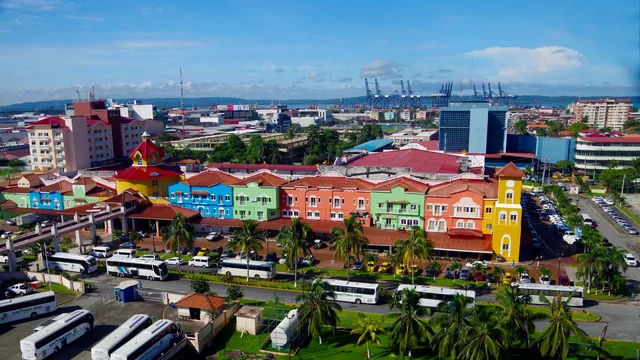Colón
Province: Colón
 Photo: Balou46 (https://commons.wikimedia.org/wiki/User:Balou46)
Photo: Balou46 (https://commons.wikimedia.org/wiki/User:Balou46)
The city of Colón is a major seaport and the capital of the Colón Province in Panama, located on the Caribbean coast at the Atlantic entrance of the Panama Canal. It is a place defined by its critical role in global commerce and its vibrant Afro-Caribbean cultural heritage.
Geographic data
| Province | Colón |
|---|---|
| Area | 2.4 km2 |
| Founded | 1852 |
| Population | 78000 |
| Elevation | 9 m |
Location and Climate
- Location: Situated on the Manzanillo Peninsula, Colón is positioned right at the mouth of the Panama Canal on the Caribbean Sea. It is the Atlantic terminal of the Panama Canal Railway.
- Climate: The city has a hot, extremely humid tropical climate (tropical monsoon). Temperatures are consistently high year-round, typically ranging from 77°F to 86°F (25°C to 30°C). The city receives very high annual rainfall, making the area lush but also intensely wet, particularly during the June to December period.
Economy and Lifestyle
- Commerce Hub: Colón's economy is centered on trade and logistics. It is the site of the Colón Free Zone (Zona Libre), one of the world's largest duty-free port and commercial areas, which attracts international business and shipping. It is also a major cruise ship port.
- Historical Significance: The city was founded in 1850 as the Atlantic terminal for the Panama Railroad, primarily to facilitate travel during the California Gold Rush, and later became essential for the construction of the Panama Canal.
- Culture: The city and province are known for a strong Afro-Caribbean culture and rhythm, influenced by the descendants of laborers imported from the West Indies to build the railroad and the canal. Cultural expressions include traditional Calypso music and the Congo dance, which is recognized by UNESCO as Intangible Cultural Heritage.
Attractions and Activities
- The Panama Canal: A visit to the Agua Clara Locks Visitor Center in the province offers spectacular, up-close views of the newer, expanded set of Atlantic locks and the ships transiting the Canal.
- Historic Fortifications: The province is home to UNESCO World Heritage Sites like the impressive ruins of Fort San Lorenzo at the mouth of the Chagres River, which was built during the Spanish colonial era to protect the route across the Isthmus.
- Natural Beauty: The surrounding province offers beautiful Caribbean beaches and islands, such as Isla Grande, which are popular for snorkeling, kayaking, and enjoying the warm, clear waters.
- Transportation: The city is connected to the Pacific side via the Panama Canal Railway, which provides a scenic passenger journey across the Isthmus parallel to the Canal.
